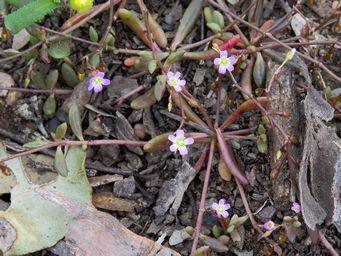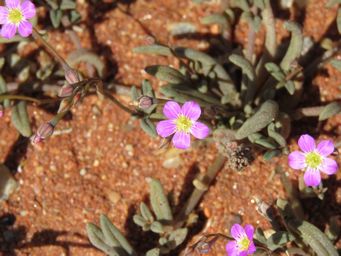Australia So Much to See
Copyright (C) 2013 AustraliaSoMuchtoSee.com. All reights reserved
Sources used for identification of wildflowers shown on these pages and regions where they occur see Credits
These pages will
feature some of the wildflowers we have photographed in Western Australia, and where possible, identified. If you
are able to help identify further flowers, or correct any I may have wrong, please contact us.
Information given for each species
will give botanical name, known common names, describe the flower, give time of year it flowered, and where it was photographed, and
the areas it occurs in. Names have been matched to Florabase which has also been used to show distribution.
See some
of these wildflower in larger sized photos on our Flickr pages.
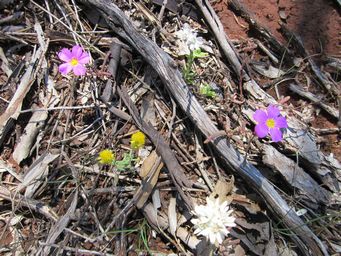
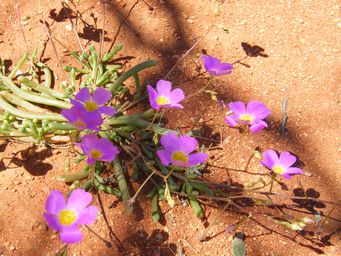
Calandrinia remota, Round-leaved Parakeelya
A small plant with succulent leaves and a spreading growth with five petalled purple
flowers. Varieties vary with or without a yellow centre.
Spring
Yalgoo, Mid West, Western Australia and found through the
Mid West Region
Calandrinia polyandra Parakeelya, Jananyungu, Kukatarri
A small plant with succulent leaves and five petalled purple flowers
with numerous stamens. Variations can be with or without a yellow centre.
Spring
Ajana, Mid West, Western Australia and
found through the Mid West, Pilbara, Goldfields and Pilbara Regions
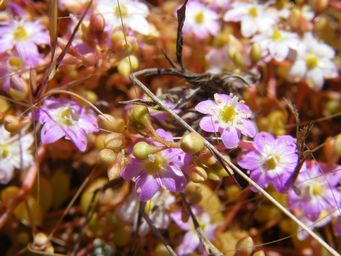
Calandrinia creethae 2022 (formerly Calandrinia creethiae)
A carpet of tiny purple six petalled flowers with thick and prominent stamens
and small bulbous succulent leaves, spreading low on the ground. Seen above right forming a thick carpet of foliage and
flowers. The fresh foliage, seen starting in August, is probably Calandrinia creethae foliage. These were spreading
across the ground ready to produce the many tiny soft pink flowers in the Mid West.
September
Mullewa, Mid West region,
Western Australia and found through the Gascoyne Murchison regions and inland deserts
Calandrinia genus is in the process of being renamed, with the option Parakeelya, in line with its Aboriginal name and common
name, being favoured.
Calandrinia
Calandrinia are a low-growing, usually annual, succulent plant, with most species having vibrant pink flowers, and are
most often found in arid areas. There are around 60 species in Western Australian growing throughout the state, with many being
so similar that only the differences in their tiny seeds will tell them apart. Foliage is succulent to store moisture for flowering,
and may appear different as the moisture is drawn out of the leaves. Many species have flowers that are tiny. Only those
that there is a fair degree of certainty have been named here.
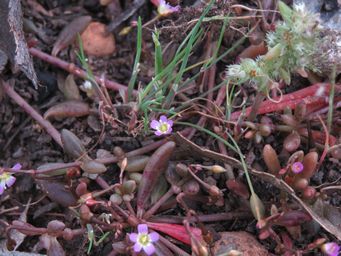
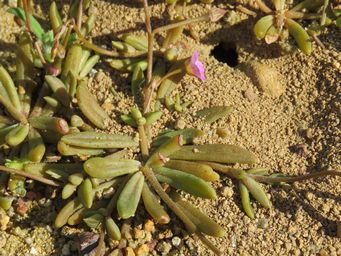
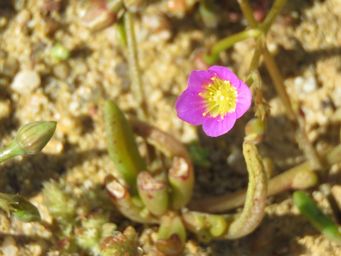
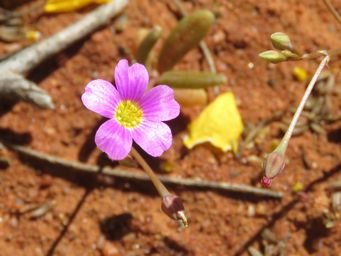
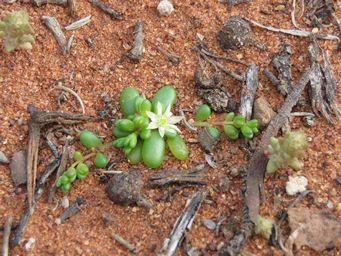
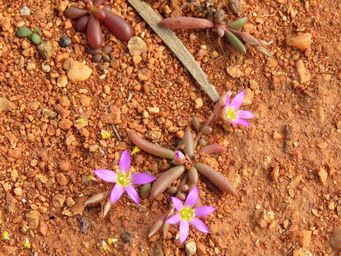
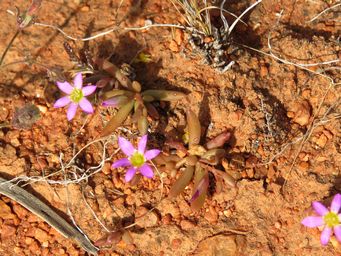
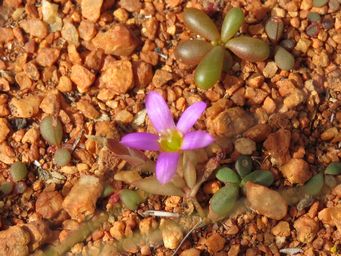
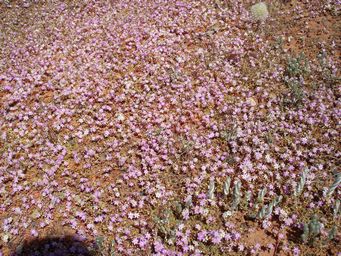
Calandrinia calyptrata, Pink Purslane, Small-Leaved Parakeelya
The Calandrinia depicted here may be the above species. A very
small pink flower. Foliage consists of a base of elongated succulent leaves with a longitudinal groove, and long stems across
the ground with smaller succulent leaves and bearing the flowers.
October
Boyup Brook in the South West region of Western Australia
(above left)
The small plant at the top right of the upper photo is Crassula colorata var colorata
Photos at right which may be the
same species seen at Merredin in August. Found in the Mid West, through the Wheatbelt, Goldfields, South West and Great Southern regions.
Calandrinia ptychosperma, Creeping Parakeelya, Wrinkly-seed Parakeelya
A small pink flower with pointed tips to the petals. Number
of petals can vary. Foliage consists of a cluster of elongated succulent leaves.
August
Sandstone in the Mid West
region of Western Australia, and occurs in the Mid West, Pilbara, northern Wheatbelt and northern Goldfields.
Calandrinia granulifera, Pygmy Purslane
Very tiny seven petalled white, cream or pale pink flowers with pointed petal tips, on very
short stems from a small plant with bobbly succulent foliage.
August
Kalgoorlie, and found through the Mid West and Wheatbelt,
into parts of the Goldfields, Great Southern and South West regions. Favours white sand.
Calandrinia eremaea, Twining Purslane, Small Purslane
With small pink flowers, both the flowers and foliage are larger than the very
tiny Calandrinia calyptrata. Foliage consisted of elongated succulent leaves with a longitudinal groove. Flowers branch
from semi prostrate or upright stems. Striping on back of sepals. This striping can be soon on the buds at lower left.
August
Above left seen west of Sandstone in the Mid West and above right at Petrudor, near Kalannie in the Wheatbelt. Found through
the Gascoyne and into parts of the Pilbara, through the Mid West, Goldfields, Wheatbelt, and Great southern regions.
